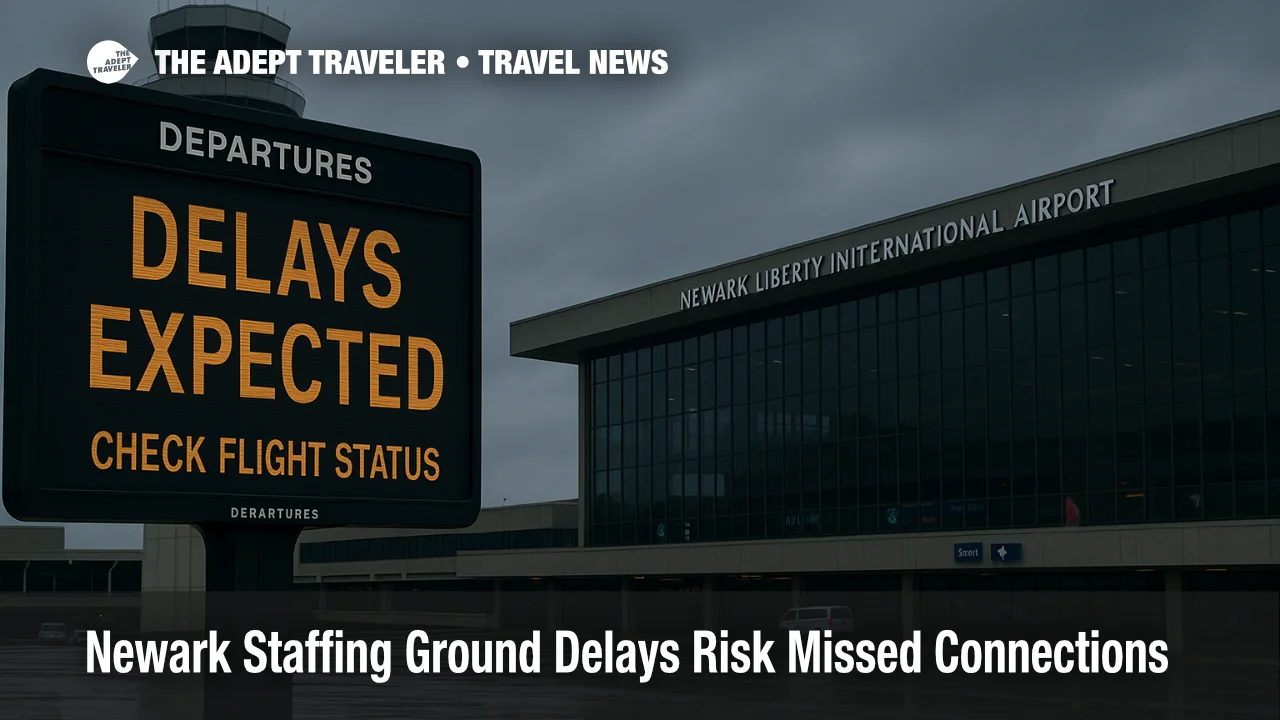Newark Staffing Ground Delays Risk Missed Connections

Key points
- FAA lifted a Newark ground stop then imposed a Ground Delay Program on November 2
- Average Newark arrival waits hovered near two hours with higher peaks reported
- Metering reduced arrival banks, raising missed-connection risk into Monday morning
- Ripple delays likely at JFK and LaGuardia per NYC Emergency Management advisories
- Travelers should protect tight connections or reroute across New York area airports
Impact
- Who Is Affected
- Arriving and connecting passengers at Newark on November 2 with spillover into early November 3 at JFK and LaGuardia
- What To Expect
- EDCT holds at origin, inflight spacing, and arrival rate caps that thin connection banks
- Connection Risk
- Short layovers during late-day and early-morning banks are most vulnerable to misconnects
- What To Do Now
- Ask your airline to protect you on a later flight, reroute to JFK or LaGuardia, or confirm an overnight if your final leg is at risk
- When It Eases
- FAA advisories indicate revisions after 12:00 a.m. ET Monday as staffing and demand change
Newark Liberty International Airport (EWR) cycled from a staffing ground stop to a Ground Delay Program (GDP) on Sunday, November 2. The FAA's morning stop, in effect from about 706 a.m. to 845 a.m. ET, gave way to metered arrivals that pushed average waits close to two hours with higher peaks on some routes. New York City Emergency Management warned that delays at Newark often spill into John F. Kennedy International Airport (JFK) and LaGuardia Airport (LGA), a pattern likely to carry into the Monday morning commute on November 3. Travelers connecting at the New York airports should protect tight layovers or request reroutes.
Newark timeline and today's arrival rates
FAA records and local reporting show the sequence clearly. The agency issued a staffing-related ground stop at Newark on Sunday morning and lifted it after nearly two hours, transitioning to a GDP that assigned departure slots to inbound flights and capped the airport's hourly arrival rate. Fox 5 New York reported the stop window as 706-845 a.m. ET, with the succeeding GDP posting average delays around 116 minutes and maximums exceeding three hours on some flows. An FAA Operations Plan advisory late Sunday night indicated that Newark's GDP would likely be revised for arrivals after 0500Z, aligning with the early hours of Monday, November 3.
NYC Emergency Management reinforced the message publicly on X, noting that Newark was under a GDP due to staffing, that arrivals were being limited, and that delays at Newark typically ripple to JFK and LaGuardia. Business Insider summarized the city's alert and the spillover risk for missed connections across the New York system.
How a GDP hits banks and connections
How it works. A Ground Delay Program meters inbound flights by issuing Estimated Departure Clearance Times (EDCTs) at their origin. Instead of everyone arriving in a tight bank, flights are spaced to fit a reduced arrival rate. That keeps the runway and tower workload within safe limits, but it thins the "waves" that airlines plan for connections. When a hub like Newark runs an arrival cap for hours, the late-morning and late-evening banks lose density. That increases minimum-connection time misses, pushes crews and aircraft out of position, and forces rolling reassignments of gates.
On Sunday, Newark's GDP narrowed the airport's hourly arrival acceptance rate while the FAA managed staffing in the New York TRACON and tower complex. Multiple outlets tracked average waits near or above two hours at points during the afternoon, and some origins saw higher peaks. The FAA's same-day Operations Plan called out further GDP revision potential overnight, which often determines whether the first morning bank runs normally or starts behind.
What to do if you misconnect
If your inbound Newark flight receives a long EDCT hold or is scheduled to arrive inside a tight layover, contact your airline before departure and ask to be "protected" on a later connection. If your ticket allows, request a reroute into JFK or LaGuardia with ground transfer to your final destination, which can be faster when Newark's arrival rate is constrained. For late-night arrivals facing extended delays, ask the carrier to confirm hotel and meal policies in case of an involuntary overnight. Keep notifications on in your airline app because GDP revisions can move EDCTs up or down with little notice.
Wider context and Monday outlook
The staffing shortfalls that triggered Sunday's stop and GDP sit within a broader nationwide constraint tied to the federal government shutdown. National coverage on Sunday cited two- to three-hour delays at Newark, with widespread ripple effects. While the FAA has a standing order that limits scheduled operations at Newark to reduce routine congestion, real-time staffing triggers can still force day-of arrival caps like those seen Sunday. The agency's late-night planning advisory suggested additional Newark GDP adjustments after midnight, which is consistent with a cautious Monday morning outlook for connections.
Final thoughts
Newark's Sunday pivot from ground stop to GDP shows how staffing constraints translate into missed-connection risk across the New York system. If you are connecting at Newark early Monday, November 3, build a wider cushion or ask to reroute across JFK or LaGuardia. Keep an eye on your EDCT and gate notifications, because the FAA signaled overnight revisions that could reshape the first wave.
Sources
- Staffing issues trigger ground stop at Newark Liberty International Airport on Sunday
- Current Operations Plan Advisory
- National Airspace System Status
- NYC Emergency Management on X
- NYC warns of hourslong delays at Newark over staffing shortages
- Flight delays persist as government shutdown leads to air traffic controller shortages
- Newark Airport Issues Ground Stop amid Staffing Issues for 2nd Time in 1 Week
